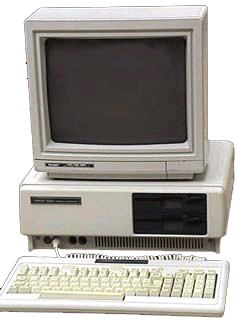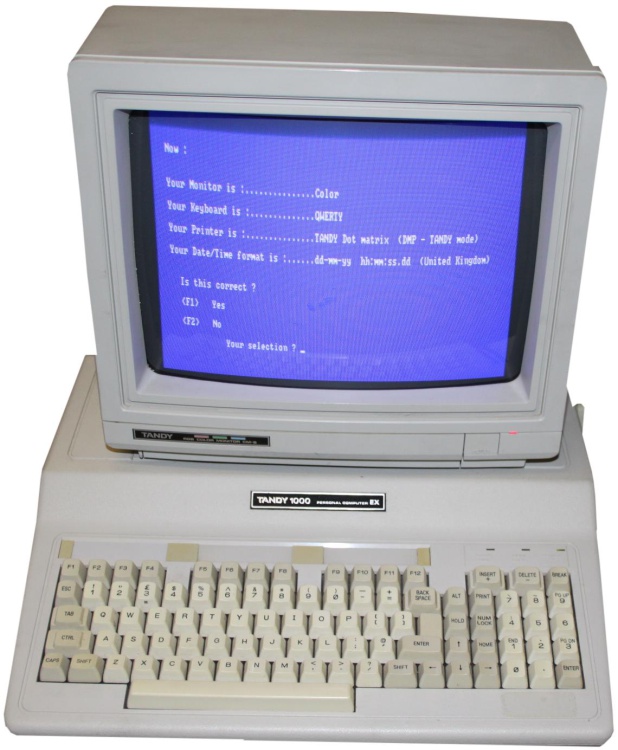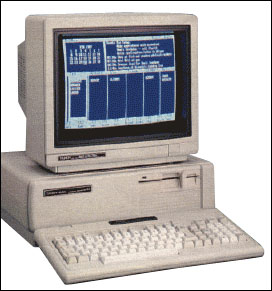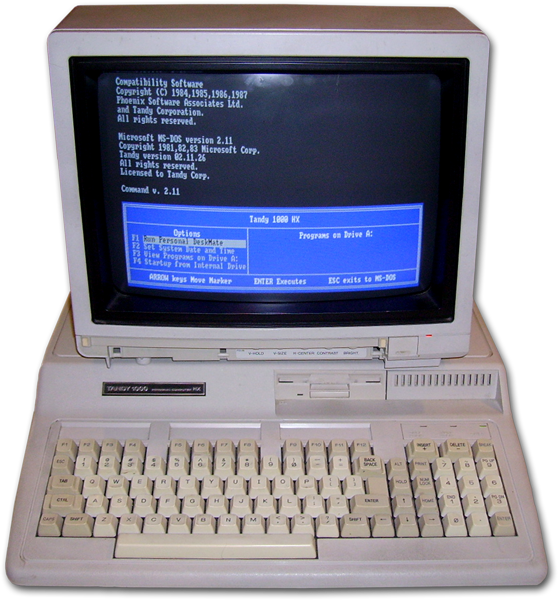Tandy 1000 Series
Introduction
1000
Tandy broke into the PC-compatible market in 1984 with their entry-level model 1000, having had great successes in the early home computer market with their TRS-80 and Color Computer range. This new offering was a clone of IBM's PC Jr (an attempt to break into the home computer market themselves). The PC Jr. was a PC with some enhancements but also with incompatibilities that would ultimately be its downfall. Before this however, Tandy saw the great potential in a low-cost PC aimed at the home market, and the 1000 was their answer to that. It was sold through Tandys own experienced network of Radio Shack stores, which were already well accustomed to selling the company's computers and its associated software.
The 1000 ran an Intel 8088 and 4.77 MHz or 7.19 MHz in turbo mode, and was fitted as standard with a single 5.25" 360 KB floppy drive. A second floppy drive could be purchased from Radio Shack and installed in a second drive bay. It had 128 KB of memory which could be expanded to 640 KB via ISA memory expansion cards. Like the PC Jr, the Tandy 1000 supported an enhanced version of CGA graphics that provided 16 colours on-screen (compared to standard CGA's 4), and 3-voice sound.
One improvement the Tandy design had over the IBM PCs was tight integration of common interfaces on the motherboard. This included a floppy disk controller, video controller, audio controller, and serial and parallel ports - these had become standard fare for all PCs at the time. All of this meant that out of the box the computer had all expansion slots free for the customer. On an IBM PC at the time, these above would have taken up 3 or 4 slots.
Tandy bundled MS-DOS 2.1 and DeskMate software with their 1000, and this software would see numerous refreshes and enhancements over the life of the 1000 series as an easy-to-use graphical user interface.
The 1000-series comprised the following models:
- 1984: Tandy 1000 (model 25-1000): Intel 8088 , single 5.25" floppy drive
- 1985: Tandy 1000A: a 'refresh' of the 1000 with a co-processor socket, and bug fixes.
- 1986: Tandy 1000EX (model 25-1050): Intel 8088 7.16 MHz, single 5.25" 360 KB floppy drive - $799
- 1986: Tandy 1000TX: Intel 80286 but with 8-bit data bus
- 1987: Tandy 1000HX (model 25:1043): Intel 8088 7.16 MHz, single 3.5" 720 KB floppy drive - $
- 1987: Tandy 1000SX (model 25-1051): Intel 8088 7.16 MHz, 384 KB RAM, two 5.25" 360 KB floppy drive - $1,199.00
- 1988: Tandy 1000SL: Intel 8086
- 1988: Tandy 1000TL (model ?): Intel 80286
- 1991: Tandy 1000RL (model 25-1450): Floppy only, no monitor - $599.95
- 1991: Tandy 1000RL (model 25-1450): Floppy only, monochrome monitor - $749.90
- 1991: Tandy 1000RL (model 25-1450): Floppy only, colour monitor - $899.90
- 1991: Tandy 1000RL (model 25-1451): Floppy drive and Hard disk, no monitor - $999.95
1000EX
 In late 1986, Tandy released the 1000EX for use in the home or in schools. Priced at $799, it ran an Intel 8088 CPU at 7.16 MHz, but could step down to run at the IBM PC original speed of 4.77 MHz. It came as standard with 256 KB of RAM (expandable to 640 KB) and a single 5.25" 360 KB floppy disk drive. Unlike the Tandy 1000 that came before it, the EX had an integrated keyboard and system unit in one. Due to its form factor, the 1000EX could not take standard ISA expansion cards - instead it accepted Tandy "PLUS" expansion boards.
In late 1986, Tandy released the 1000EX for use in the home or in schools. Priced at $799, it ran an Intel 8088 CPU at 7.16 MHz, but could step down to run at the IBM PC original speed of 4.77 MHz. It came as standard with 256 KB of RAM (expandable to 640 KB) and a single 5.25" 360 KB floppy disk drive. Unlike the Tandy 1000 that came before it, the EX had an integrated keyboard and system unit in one. Due to its form factor, the 1000EX could not take standard ISA expansion cards - instead it accepted Tandy "PLUS" expansion boards.
It was shipped with a special version of DeskMate, called Personal DeskMate. This incorporated a word processor, spreadsheet, electronic filer, paint, calendar, and communication applications, as well as desktop accessories like a calculator, notepad and phone directory. Also bundled was MS-DOS 2.11 with GW-BASIC.
1000SX
 The 1000SX was essentially the same as the Tandy 1000EX, but in the standard PC mould with a separate system unit and keyboard (like the original 1000). Finally here was a machine with five 8-bit ISA slots for expansion, could support an EGA or VGA card, hard disk controller, and a math coprocessor. It was still running an Intel 8088 at 7.19 MHz and came with just 384 KB of RAM (easily expandable to 640 KB with standard DRAM chips), but also got a DMA controller. With the SX, Tandy had really distanced itself from the PC Jr. issues and entered the "real" PC compatible world. It was bundled with MS-DOS 3.2 which added 720 KB floppy disk support.
The 1000SX was essentially the same as the Tandy 1000EX, but in the standard PC mould with a separate system unit and keyboard (like the original 1000). Finally here was a machine with five 8-bit ISA slots for expansion, could support an EGA or VGA card, hard disk controller, and a math coprocessor. It was still running an Intel 8088 at 7.19 MHz and came with just 384 KB of RAM (easily expandable to 640 KB with standard DRAM chips), but also got a DMA controller. With the SX, Tandy had really distanced itself from the PC Jr. issues and entered the "real" PC compatible world. It was bundled with MS-DOS 3.2 which added 720 KB floppy disk support.
1000HX
 In 1987 Tandy expanded their 1000-range with the launched of the 1000HX. This was designed as the successor to the 1000EX, with a similar integrated keyboard and system unit. It came with a 3.5" 720 KB floppy drive, 256 KB of RAM, and had DOS 2.11 in ROM for fast boot-up. As with the 1000EX, this meant the HX didn't support standard ISA slots, instead requiring 62-pin "Plus" cards for expansion. Actually, the "Plus" port is pin-compatible with an 8-bit ISA slot, so you can make an adapter if you wish to use standard ISA expansion cards in an HX.
In 1987 Tandy expanded their 1000-range with the launched of the 1000HX. This was designed as the successor to the 1000EX, with a similar integrated keyboard and system unit. It came with a 3.5" 720 KB floppy drive, 256 KB of RAM, and had DOS 2.11 in ROM for fast boot-up. As with the 1000EX, this meant the HX didn't support standard ISA slots, instead requiring 62-pin "Plus" cards for expansion. Actually, the "Plus" port is pin-compatible with an 8-bit ISA slot, so you can make an adapter if you wish to use standard ISA expansion cards in an HX.
It was bundled with DeskMate II on floppy disk.
1000RL
In July 1991 Tandy launched the 1000RL, which comprised a floppy disk-only model or one with a floppy drive and hard disk. Just as with all the 1000-series, this was an XT-class computer, running an Intel 8086 microprocessor at 9.54 MHz, and 512 KB RAM. The RL was designed for home use, and so it came with a new version of DeskMate called DeskMate Home Organizer. This had 15 new applications divided into 3 categories: Personal, Kitchen, and Financial. The Home Organizer version also got 9 other applications which were Desktop, Text, Draw, PC-Link, Telecon, Hangman, Music, Sound, and Address Book. With the 1000RL Tandy finally standardised the mouse port (now PS/2) and the parallel port (now Centronics), just like the 2000, 3000 and 4000 computers.
The 1000RL came in two configurations: the 25-1450 was a single floppy drive while the 25-1451 got a floppy drive and 20 MB hard disk. This also came with the "SmartWatch" realtime clock built-into the motherboard. The 25-1451 model had MS-DOS and DeskMate pre-installed on the hard disk.
Options
A number of optional accessories or upgrades were available for the 1000-series:
For 1000EX:
25-1014: PLUS RS-232C Option Card - $79.95
25-1015: PLUS Digi-Mouse Controller/Calendar - $99.95
25-1017: PLUS 300 baud PC Modem - $99.95
25-1018: PLUS 1200 baud PC Modem - $199.95
25-1019: PLUS Network 4 Interface
- $299.95
25-1020: VM-4 Monochrome Monitor - $129.95
25-1022: CM-10 RGBI Colour Monitor - $459.95
25-1023: CM-5 RGBI Colour Monitor - $299.95
25-1062: Memory Plus Expansion Adapter - $129.95
For 1000HX:
25-1060: External 5.25" 360 KB Floppy Drive
- $
For 1000RL:
25-1033: SmartWatch socket (for adding a realtime clock) - $39.95
25-1042: PS/2-style mouse - $49.95
25-1047: 20 MB SmartDrive - $
25-1075: 3.5" floppy disk drive- $
25-1082: 256 KB RAM expansion - $59.95
25-????: 2400bps modem - $
Compatibility
Hardware - BIOS
The Tandy 1000 used a Phoenix BIOS. The original version 01.00.00 is known to cause data corruption with some types of hard disk controllers. This was fixed in version 01.01.00 along with a few other bugs. The BIOS is held in two chips, both of which are 32 KB in size. If you need to replace these two chips, you can use two 28C256 chips.
Hardware - Drives
The Tandy 1000 came with IBM-standard floppy disk controller embedded on the motherboard, and which supported two drives. There was no direct support for hard disks with this model as they were very expensive, and the 1000 was designed as an entry-level model.
The 1000RL got a hard disk option called the "SmartDrive", which was a 20 MB affair. If purchased later for a non-HD 1000RL, the hard disk came with initialization software that ran in DeskMate.
The 1000EX had an expansion port on the back that supported connection of an external floppy drive (either 5.25" 360 KB or 3.5" 720 KB).
Tandy floppy disk drives require a ribbon cable without a twist! They also require setting jumpers or switches on the drives to tell the machine which is drive A and which is drive B. On an IBM PC, both drives are set to DS1, and the twist turns the drive at the end of the cable to DS0. If you are using a modern 1.44MB drive in these systems, they are generally soldered to DS1, so they will be the B drive. 5.25" drives should always allow you to set DS0 or DS1. But one of the great things about a Tandy is that they allow you to boot from the B drive by pressing the F3 key at startup. If you have a standard "universal" floppy cable (with 3x pin connectors and 2x card connectors), you have to untwist the cable by prying off the end connectors, flipping the wires around, then snapping the connectors back on again. Tandy did not support high density drives until the RLX and TL/3, but you can use most 1.44MB floppy drives with double density/720KB media.
All early Tandy 1000s (1000, 1000A, and 1000EX) with a hard disk used IRQ 2 for the hard disk and IRQ 5 for video. On an IBM PC and compatible these were the other way around. This could lead to issues if you were trying to fit a third-party hard disk whose controller insisted on using IRQ 5, or a video card that only worked on IRQ 2! The 1000SX (and beyond) fixed this.
For modern Tandy "retro" users, do bear in mind that Tandy MS-DOS 3.0 through to 3.3 only supports hard disk partitions of 32 MB each. DOS 3.3 added support for extended partitions
Hardware - KEYBOARD
The Tandy 1000 uses a proprietary keyboard port with an 8-pin DIN along with two joystick ports (6-pin DIN). All of these are compatible with Tandy's earlier TRS-80 home computers, and hence are not compatible with IBM hardware. These ports are all situated on the front of the system unit. The keyboard is also a little different to most PCs. There is no SCROLL LOCK key - instead you use the combination of CTRL-BREAK.
The keyboad on the 1000EX has 90 keys.
Hardware - Video
On models that pre-date the SL/TL/RL models, these came with IBM PC Jr graphics. This is both BIOS- and memory-compatible with CGA, though not register-compatible. This graphics standard is sometimes referred to a TCGA, TGA, Tandy CGA, or Tandy Video I. This basically adds several resolutions onto the standard CGA ones. They are:-
- 160 x 200 x 16
- 320 x 200 x 16
- 640 x 200 x 4
Most CGA programs that go through the BIOS to interface with the video adapter will work.
Because PC Jr/Tandy graphics aren't register-compatible with EGA, the Tandy cannot 'emulate' EGA. The same is true of the lower-res EGA resolution of 320 x 200 x 16 - the Tandy might be able to handle that resolution at that colour depth, but the register mappings mean it's not true EGA, so EGA programs won't work.
When Tandy introduced the RL, SL and TL models, they upgraded the video adapter to what is sometimes called ETGA or Tandy Video II. This takes either a digital CGA or mono TTL monitor, and pressing Ctrl-Alt-Shift-V reboots the system and switches monitor types. The setting is stored on an EPROM so that further reboots will assume the same monitor is still connected. When a mono TTL monitor is used, the video is compatible with Hercules. When a CGA monitor is used, the video is fully compatible with CGA and PC Jr. Tandy Video II has all the graphics modes of Tandy Video I, but adds 640 x 200 x 16. The BIOS does not support this mode, but programs that directly talk to the video circuitry via its registers will work.
The following titles are known to have supported this special Tandy video mode:
- Deskmate 3
- Mario Teaches Typing
- Math Rabbit Deluxe
- Sargon V
- Star Trek 25th Anniversary
- Time Riders in American History
- Treasure Cove
- Treasure MathStorm
The Tandy 1000 has both a 9-pin DSUB (marked "RGBI") for connection to a colour monitor, a second 9-pin DSUB (marked "VIDEO") for connection to a monochrome monitor, and a couples of 'phone' connections (marked "V/A") for wiring up to a television via an RF modulator. It has a second RCA socket which is the audio line-out.
The Tandy 1000 reserves 16 KB of RAM for video memory. This is the same as the IBM PC Jr. It is worth mentioning that the PC Jr did not need a DMA (Direct Memory Access) controller - this is because the 128 KB of RAM was shared between system and video, so the RAM was continually being refreshed by the video controller. When Tandy made it's "PC Jr clone" (the 1000), they did the same thing - omitted a DMA controller. The same was true of the 1000A, 1000EX, and 1000HX. The was noticeable in certain circumstances, such as when the CPU was accessing the disk drive it would "ignore" keystrokes.
The Tandy 1000 can switch between 80-column text mode and 40-column text mode by simply pressing the F12 key. The default 80-column text mode on the Tandy annoyingly uses 225 lines. IBM uses a 200 line text mode. All graphics modes in these machines use 200 lines. In order to get a proper aspect ratio with the graphics modes, the monitor's vertical size control has to be set almost to the point where the graphics are almost hidden by the monitor bezel. When you return to the text mode, this winds up cutting off either the top, bottom or both lines of the display. Use Tandy MS-DOS 3.2 mode.com command: mode 200, to fix this. This does not work in the TL machines.
Like the Tandy 1000, the 1000EX got a composite video out socket on the back as well as an RGBI port for connection to a colour monitor.
Hardware - MONITORS
Several monitors were made available for use with the Tandy 1000 series. The CM-5 was a CGA colour monitor that supported all the Tandy 1000-series resolutions. The CM-4 was an older version of the CM-5.
The CM-11 is also a CGA monitor, but has a much higher dot pitch than the CM-5, which makes the image much clearer. Both the CM-2 and CM-10 are older versions of the CM-11.
The VM-1 is a monochrome monitor that was designed for the Tandy 2000.
The VM-2 and VM-4 are both monochrome composite monitors, designed to be used with the composite CGA port on the 1000, 1000HX, 1000EX, 1000SX and 1000TX.
The VM-3 and VM-5 are also monochrome monitors, but are digital TTL (MDA/Hercules-compatible). These can be used with a 1000SL, 1000TL or 1000RL only.
EGMs are EGA monitors, and VGMs are VGA monitors.
Hardware - PORTS
The original Tandy 1000 came with a lot of ports, but many were only compatible with Tandy's own TRS-80, not IBM PC-standard. This included the two joystick ports as well as the mouse port.
The parallel interface was a proprietary edge connector at the back of the T-1000 system unit, instead of the more common Centronics 25-pin DSUB connector seen on IBM PCs and other compatibles.
The T-1000 also came with a light pen port.
Operating System
.
Software
.
Expansions
The Tandy 1000RL came with a single 10" 8-bit ISA expansion slot.
The Tandy 1000EX, being an integrated unit like many home computers couldn't take any standard ISA cards. Instead it had capacity for a single "PLUS" expansion board or two PLUS expansion boards when used with the Memory PLUS Expansion Adapter. These "PLUS" expansion cards used the same interface as the 8-bit ISA standard, and eventually Radio Shack would sell adapters in their stores that allowed PLUS cards to be inserted into a standard 8-bit ISA slot.
The Tandy 1000SX had five 10" 8-bit ISA expansion slots.
Memory
The Tandy 1000 can be expanded to the full 640 KB by installing a memory expansion card into one of the free 8-bit ISA expansion slots. The card from Tandy (and some other authorised peripheral companies) actually comes with a DMA controller for faster (direct) access to it.
For the 1000EX and 1000HX, these too require an expansion card to increase memory capacity, but these must be "PLUS" expansion cards, since these computers don't have standard ISA slots.
All other systems can take standard DRAM chips directly on the motherboard. You can use faster chips than are required. The SX will take eight 256k x 1 150ns chips. You will also need to remove jumper E1-E2.
The TX uses four 64k x 4 120ns DRAM chips. The chips go in the sockets labelled U54-57. Remove the jumper labelled E9-E10.
The TL uses four 64k x 4 120ns DRAMs. The chips go in the sockets labelled U36-39. There is no jumper to move.
The TL/2 uses four 64k x 4 120ns DRAMs. The chips go in the sockets next to the other RAM chips, in front of the expansion slots. There is no jumper.
The TL/3 uses four 64k x 4 100ns DRAMs. The chips go in the sockets labelled U4-7. There is no jumper.
The SL uses eight 64k x 4 120ns DRAMs. They go in the sockets next to the other chips. There is no jumper. The SL/2 uses 4 64k x 4 120ns DRAMs. They go next to the other chips. There is no jumper.
The RL and RL-HD use two 256k x 4 100ns DRAMs. They go in the sockets labelled U19 and U23. There is no jumper.
The RLX uses four 256k x 4 100ns "ZIP" DRAMs. This not a common type of chip. They go in the sockets labelled U23-26. There is no jumper.
The RLX-B uses four 256k x 4 100ns "ZIP" DRAMs. They go in the sockets labelled U2, U4, U5, and U9. There is no jumper.
The RLX-HD, RLX-HD-B and RSX's came from the factory fully populated with conventional RAM.
ZIP DRAMs for the RLX are hard to find. You are looking for Samsung chip #KM44C256AZ-8.
When you install additional conventional memory in your system, whatever video memory was being "stolen" by DOS goes back to the video, if DOS has 640 KB. The amount of DOS RAM you gain by the upgrade thus may not be equal to the amount of RAM you install, since whatever was stolen before is lost. There is no way to make the Tandy BIOS allocate more than 640 KB for DOS, and no way to do it by programming either.
VIDEO
On the original 1000, 1000A, and 1000HD, you cannot upgrade the video to VGA. On these systems, the BIOS will not scan for a video ROM or disable the onboard video. This is deliberate. Upon startup, one of the first things the BIOS does is scan for ROMs on your expansion cards. On VGA cards, their ROMs are usually stored at address C000:0000. Hard disk controllers usually have their ROMs at address C800:0000. So because the Tandy is programmed to ignore EGA or VGA cards it starts its scan at address C800:0000, allowing it to pick up other cards, but not video cards.
The EX and HX can have VGA but will need a special "PLUS" card because of their nonstandard expansion slots. The SX and TX need to have DIP switch 1 turned off.
The SL's, TL's and RL's won't require any hardware changes; just plug in the card.
The RLX's and RSX's came as standard with VGA. Both can accept upgrade video cards as well.
Some programs may mis-identify your VGA card as CGA or EGA. This is because the Tandy BIOS fails to set the Video Configuration Code byte at 0040:008A. The default value of this byte is 3Fh. The correct values are:
0Bh - for a single VGA color card;
0Ch - for a dual-monitor system with VGA color and MDA mono;
0Dh - for a single VGA mono board;
0Eh - for a dual-monitor system with mono VGA and MDA.
The solution is to put a short program in your autoexec.bat file that will set this byte to the correct value upon startup. Without the fix, the VGA card will function, but some programs will misidentify it as EGA or CGA. There are various programs around to do this. Radio Shack included one with their version of the Paradise card, Get vgafix.zip.
Hard Drive Support
.
Math Co-Processor
Operating System
.
Other
Media
.
Physical Characteristics
1000RL - 14" (W) x 15" (D) x 2 7.8" (H)